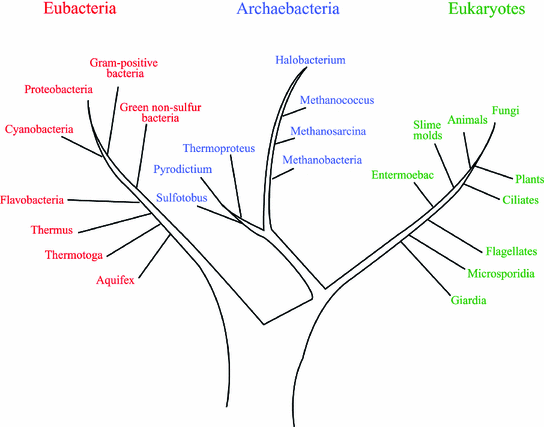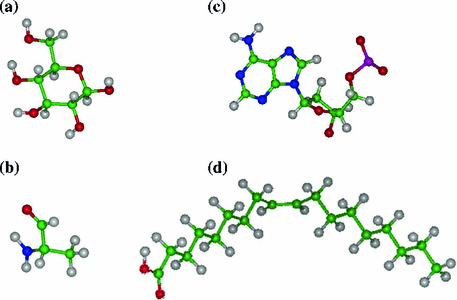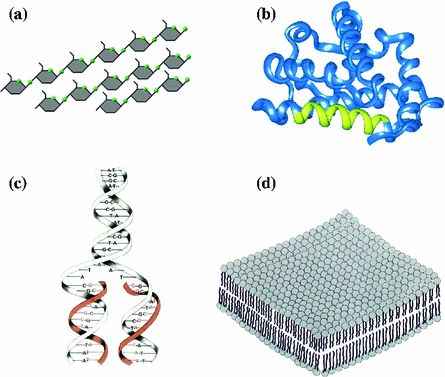1.1 The Three Kingdoms of Life
Living organisms are divided into three kingdoms, the eukaryotes , the eubacteria , and the archaebacteria . The eubacteria and the archaebacteria, which among themselves differ as much as they do from eukaryotes, are conventionally grouped together as prokaryotes . The bacteria common to most people, e.g., E. coli bacteria or the bacteria in sour milk , are eubacteria. Archaebacteria are typically found in rather hostile environments, such as in hot springs, at the bottom of deep sea, or in the very acidic milieu of the cows stomach. These bacteria do not tolerate oxygen and they often present a health hazard to humans. Eukaryotes are animals, plants, and fungi and include also single-cell organisms like yeast . Figure gives examples of single cells from the three kingdoms.
Despite their difference in appearance and functioning, archaebacteria, eubacteria, and eukaryotes are all made from the same basic molecular building blocks and they are all based on the same chemistry. Although it is generally believed that all cells have a common ancestor , the ancient evolutionary history of the different cell types is subject to considerable dispute. The three kingdoms and their interrelations are often represented by a so-called universal phylogenetic tree as shown in Fig..
Fig. 1.1
Examples of cells from the three kingdoms of life. a An archaebacterium: Methanococcus jannischiiwas . Diameter about 2

m. b A eubacterium: Escherichia coli . Size about 23

m. c Eukaryotes: Human red and white blood cells shown together with a platelet . The diameter of the red blood cell is about 6

m. The cells from the three kingdoms are not drawn on the same scale
Fig. 1.2
Phylogenetic tree with the three kingdoms of life: eubacteria, archaebacteria, and eukaryotes. The relative distance between the organisms is proportional to the evolutionary distance as determined by ribosomal-RNA nucleotide sequencing
Although the origin of life on Earth is a controversial and unresolved problem, it is a reasonable assumption that the first cellular living systems on Earth were assembled from four types of molecular building blocks: (i) information-storing molecules capable of reproduction, (ii) enzyme-like catalysts encoded by that information and able to enhance reproduction rates, (iii) molecules capable of storing energy and using this energy to convert molecules into organized assemblies of biologically active molecules, and (iv) special boundary-forming molecules capable of encapsulating and protecting the former three types of molecules. The last category of molecules is the focus of the present book.
1.2 The Molecules of Life
All cells are built from small organic molecules that are based on the chemistry of carbon . These small molecules belong to essentially four classes: the sugars , the amino acids , the nucleotides , and the fatty acids . Examples of these small elementary building blocks of living matter are given in Fig..
Fig. 1.3
Examples representing the four classes of small organic molecules that are the building blocks of all living matter. a Sugar: glucose. b Amino acid: alanine . c Nucleotide: adenosine . d Fatty acid: oleic acid
The small organic molecules are combined with other molecules from the same class or with molecules from the other classes to make larger entities, so-called macromolecules or macromolecular assemblies . There are basically four classes of these larger entities, the poly-saccharides , the proteins , the nucleic acids , and the fats (lipids and membranes) , as illustrated in Fig..
Fig. 1.4
Examples representing the four classes of larger macromolecular entities of which all living matter is composed. a Poly-saccharide: cellulose . b Protein: myoglobin . c Nucleic acid: DNA in the form of a double helix . d Lipid assembly: lipid bilayer membrane . The different macromolecules and assemblies are not drawn on the same scale
Proteins are also called poly-amino acids (or poly-peptides ) , and nucleic acids are called poly-nucleotides , reflecting the fact that proteins and nucleic acids, just like poly-saccharides, are biopolymers , i.e., long-chain molecules composed of many monomers that are bound together by strong chemical bonds.
Since there are about twenty different types of amino acids in Nature and since a protein can consist of up to several hundreds of amino acids, a very large number of different proteins can be perceived. Similarly, the five different nucleotides used by Nature allow for an immense richness in different nucleic acids that make up DNA (deoxyribonucleic acids) and RNA (ribonucleic acids). Like proteins, the nucleic acids are linear molecules , and it is the particular sequence of the monomers that determines the properties of both proteins and nucleic acids. DNA and RNA contain the genetic information that is organized in genes . The entire DNA string of an organism is termed the genome which can contain millions of nucleotides. For example the human genome includes about 27,000 genes composed of over 3 billion nucleotides. In addition to encoding genetic information, nucleotides also perform functions as energy carriers (ATP, adenosine triphosphate) , catalysts , and messengers .
When it comes to the sugars , living organisms exploits a large number of different mono-saccharides . Hence it is not uncommon to find hundreds of different poly-saccharides in a cell. Sugars allow for additional complexity in the type of materials that can be built because they can combine into branched macromolecular networks . Such networks are responsible for forming biological fibers and scaffolding and they are also an important part of the cells recognition system .
We are then left with the fatty acids and the lipids. In contrast to the sugars, the amino acids, and the nucleotides, lipids do not link chemically to form poly-lipids. No such thing exist under natural conditions. Instead they form loose macromolecular (or supra-molecular) assemblies of which the lipid bilayer membrane shown in Fig. d is the most prominent example. In some cases, lipids combine chemically with proteins and sugars. However when forming living matter, lipids usually maintain their molecular integrity. The lipid bilayer is the core of all biological membranes . A lipid bilayer membrane contains billions of lipid molecules and a cell membrane often contains hundreds of different kinds of lipids .

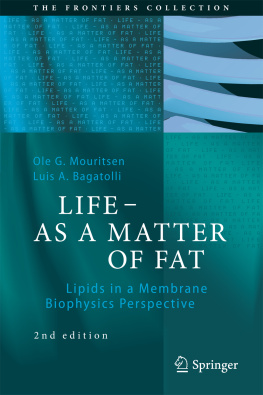




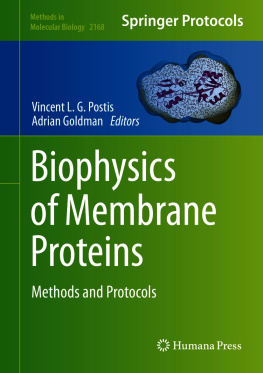






 m. b A eubacterium: Escherichia coli . Size about 23
m. b A eubacterium: Escherichia coli . Size about 23  m. c Eukaryotes: Human red and white blood cells shown together with a platelet . The diameter of the red blood cell is about 6
m. c Eukaryotes: Human red and white blood cells shown together with a platelet . The diameter of the red blood cell is about 6  m. The cells from the three kingdoms are not drawn on the same scale
m. The cells from the three kingdoms are not drawn on the same scale